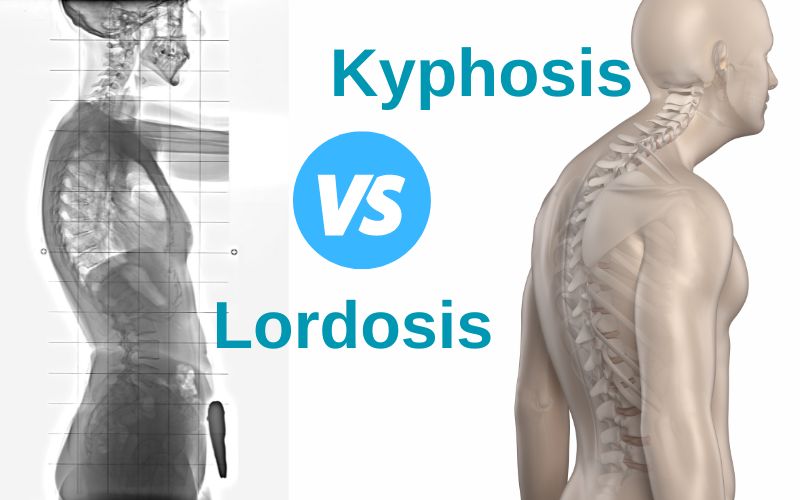Our spine plays a significant role in human anatomy because it supports the weight management structure of the body, allows it to maintain a good posture, and engages in flexible movements.
The spine has natural and healthy curvatures that differ from person to person. Kyphosis and Lordosis are two types of spinal conditions involved in abnormal curvatures. Kyphosis is the spinal curve that bends outwards, while Lordosis bends inwards towards the body’s centre.
Key difference between Kyphosis and Lordosis
Kyphosis is a spinal deformity when there is excessive forward bending of the spine that results in abnormal rounding of the upper back in the thoracic region. Initially, Kyphosis does not affect much, but serious kyphosis results in chronic pain and disfiguring.
Lumbar Lordosis is another medical condition where the spine curvatures push inwards the body. This condition is also known as swayback, and it results in the abdomen bulging forward and the hip pushing backwards.
The key difference between kyphosis and lumbar lordosis is that kyphosis is prominent only in the thoracic region, while lordosis is normal for the neck and lower back.
Symptoms of Kyphosis and Lordosis
Kyphosis and Lordosis are spinal deformities that affect the shape of the human structure. Let us see the common symptoms of these medical conditions.
Symptoms of Kyphosis
- Visible curve or hump in the upper back.
- Feeling tingling, weakness, or numb legs.
- The shoulders become excessively rounded.
- Experiencing excessive fatigue.
- Inability to balance the body
- Acute pain and stiffness in the neck and back
- Difficulty in breathing and pinched nerves.
Symptoms of Lordosis
- Protruded abdomen and swayed back hips.
- The head and neck appear to lean forward.
- There is a visible gap between the lower back and the floor when lying on the back.
- Experiencing tingling and numbness in the legs
Types of Kyphosis and Lordosis
Here are a few types of Kyphosis as follows:
This kind of spinal deformity is present since birth when the development of the spine is not normal when the baby is in the womb of the mother. It’s visible when the child grows and is characterised by a difference in the shape of one or two vertebrae.
- Scheuermann’s Kyphosis
Scheuermann’s kyphosis is more prominent to occur during the teen years. It is a severe problem that causes the vertebrae to develop a wedge or sharp shape, making the spine appear to hunch forward. This type of Kyphosis needs medical attention as it causes extreme pain in the neck and back.
- Postural Kyphosis
Postural Kyphosis is one of the most common types of kyphosis, and it occurs when the thoracic spine has a curve of more than fifty degrees. The most common cause of postural kyphosis is not maintaining a proper posture or slouching. It can be cured with physical therapies and does not lead to any structural deformities.
The common types of Lumbar Lordosis are described below.
- Postural Lordosis
Postural Lordosis is commonly caused due to standing and sitting for prolonged periods without maintaining a proper posture. spinal deformities specialist in Delhi says, obesity and weak back and stomach muscles also lead to Postural Lordosis.
- Traumatic Lordosis
Any injury or fracture in the spine that causes deformity in its structure is called Traumatic Lordosis. This causes the forward bedding of the spine.
- Post-surgical laminectomy hyperlordosis
Hyperlordosis is a condition in which the spines bend outwards abnormally. This type of lordosis is caused after surgery, which involves removing a part of the vertebrae.
- Neuromuscular Lordosis
Certain disorders like muscular dystrophy, spinal muscular atrophy, or myelomeningocele cause spinal deformation problems. This type of spinal deformity is known as Neuromuscular deformity.
When to See a Spine Doctor in Delhi
Initially Kyphosis can be cured by maintaining a good posture and taking physical therapy. However, if you are suffering from persistent and acute back pain, difficulty in maintaining an upright body posture, difficulty in breathing and extreme fatigue, you should visit a kyphosis doctor in Dwarka. Kyphosis is complicated for older people because their bone density decreases and their spinal disc degenerates, causing compression of the spine.
When you notice visible unnatural inward crooking in your spine and feel difficulty in standing straight, you must visit a Lordosis doctor in Dwarka, as Lordosis can cause muscle spasms and, in serious cases, it causes numbness and tingling in the legs, which restricts the movement. Lordosis can be cured through physical therapy, bracing or surgery in complicated cases.
Prevention of Kyphosis and Lordosis
Some ways in which you can prevent Kyphosis and Lordosis are as follows.
- Maintaining a healthy weight prevents adding additional weight and strain on the spine. It helps to balance the body effectively.
- Exercising regularly and taking strength training for strong upper and lower back and stomach muscles helps to improve spinal posture.
- Maintaining a correct posture while sitting, standing and sleeping helps to reduce excessive strain on the spine.
- Maintaining a healthy diet and adding calcium and vitamin D in your diet for strong bones and muscles.
The spine is a key structure in our body, so taking care of your body posture is essential. Any malformation in the vertebrae disturbs the body posture and can cause serious issues. So, you must make the right decision when the symptoms become visible. Centre for Brain and Spine has experienced spine doctor in Delhi, and Dr Nagesh help to identify the type of spinal deformity you are suffering from and provide possible solutions for it.
General Questions
Kyphosis is a spinal deformity of excessive forward bending of the spine while Lumbar Lordosis is a problem when spine curvatures push inwards the body.
Cat Cow Sketch, Plank and Wall angels are some of the good exercises for healthy and normal spine.
You can consult Dr. Nagesh Chandra, who is one of the best good spine doctor in Delhi. His brain and spine clinic is in Dwarka

